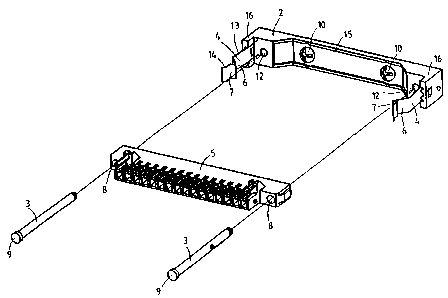Some of the information on this Web page has been provided by external sources. The Government of Canada is not responsible for the accuracy, reliability or currency of the information supplied by external sources. Users wishing to rely upon this information should consult directly with the source of the information. Content provided by external sources is not subject to official languages, privacy and accessibility requirements.
Any discrepancies in the text and image of the Claims and Abstract are due to differing posting times. Text of the Claims and Abstract are posted:
| (12) Patent Application: | (11) CA 2062823 |
|---|---|
| (54) English Title: | DEVICE FOR CONNECTING CONTROL CURRENT LINES |
| (54) French Title: | DISPOSITIF DE RACCORDEMENT DE LIGNES DE COMMANDE |
| Status: | Deemed Abandoned and Beyond the Period of Reinstatement - Pending Response to Notice of Disregarded Communication |
| (51) International Patent Classification (IPC): |
|
|---|---|
| (72) Inventors : |
|
| (73) Owners : |
|
| (71) Applicants : |
|
| (74) Agent: | BERESKIN & PARR LLP/S.E.N.C.R.L.,S.R.L. |
| (74) Associate agent: | |
| (45) Issued: | |
| (86) PCT Filing Date: | 1991-04-17 |
| (87) Open to Public Inspection: | 1991-10-31 |
| Examination requested: | 1998-04-02 |
| Availability of licence: | N/A |
| Dedicated to the Public: | N/A |
| (25) Language of filing: | English |
| Patent Cooperation Treaty (PCT): | Yes |
|---|---|
| (86) PCT Filing Number: | PCT/EP1991/000732 |
| (87) International Publication Number: | EP1991000732 |
| (85) National Entry: | 1991-12-24 |
| (30) Application Priority Data: | ||||||
|---|---|---|---|---|---|---|
|
2062823 9116742 PCTABS00008
A device is disclosed for connecting control current lines in low
voltage switchboard plants. The device should allow the control
current in a plug-in distribution board to be easily maintained
up to a test position of the rack and to be cut beyond this
position when the rack is drawn out. The device has two multipoint
plugs with plugs and sockets, of which the first is rigidly linked to
the rack and the other is movably mounted over a limited path on
two guiding pins the terminal cross-section of which is
enlarged. In the test position, they are locked-in by elastic elements,
ensuring complete contact between both multipoint plugs in this
position already, when the rack is inserted. A plurality of control
lines can be thus easily cabled with little attrition, in a
reduced space within a plug-in distribution board and a test position
can be reached by drawing out he rack.
Note: Claims are shown in the official language in which they were submitted.
Note: Descriptions are shown in the official language in which they were submitted.

2024-08-01:As part of the Next Generation Patents (NGP) transition, the Canadian Patents Database (CPD) now contains a more detailed Event History, which replicates the Event Log of our new back-office solution.
Please note that "Inactive:" events refers to events no longer in use in our new back-office solution.
For a clearer understanding of the status of the application/patent presented on this page, the site Disclaimer , as well as the definitions for Patent , Event History , Maintenance Fee and Payment History should be consulted.
| Description | Date |
|---|---|
| Inactive: IPC from MCD | 2006-03-11 |
| Application Not Reinstated by Deadline | 2003-03-05 |
| Inactive: Dead - Final fee not paid | 2003-03-05 |
| Deemed Abandoned - Failure to Respond to Maintenance Fee Notice | 2002-04-17 |
| Deemed Abandoned - Conditions for Grant Determined Not Compliant | 2002-03-05 |
| Notice of Allowance is Issued | 2001-09-05 |
| Letter Sent | 2001-09-05 |
| Notice of Allowance is Issued | 2001-09-05 |
| Inactive: Approved for allowance (AFA) | 2001-08-21 |
| Amendment Received - Voluntary Amendment | 2000-11-09 |
| Inactive: S.30(2) Rules - Examiner requisition | 2000-05-11 |
| Amendment Received - Voluntary Amendment | 1998-09-10 |
| Inactive: RFE acknowledged - Prior art enquiry | 1998-04-29 |
| Inactive: Status info is complete as of Log entry date | 1998-04-29 |
| Inactive: Application prosecuted on TS as of Log entry date | 1998-04-29 |
| All Requirements for Examination Determined Compliant | 1998-04-02 |
| Request for Examination Requirements Determined Compliant | 1998-04-02 |
| Deemed Abandoned - Failure to Respond to Maintenance Fee Notice | 1997-04-17 |
| Inactive: Adhoc Request Documented | 1997-04-17 |
| Application Published (Open to Public Inspection) | 1991-10-31 |
| Abandonment Date | Reason | Reinstatement Date |
|---|---|---|
| 2002-04-17 | ||
| 2002-03-05 | ||
| 1997-04-17 |
The last payment was received on 2001-04-10
Note : If the full payment has not been received on or before the date indicated, a further fee may be required which may be one of the following
Patent fees are adjusted on the 1st of January every year. The amounts above are the current amounts if received by December 31 of the current year.
Please refer to the CIPO
Patent Fees
web page to see all current fee amounts.
| Fee Type | Anniversary Year | Due Date | Paid Date |
|---|---|---|---|
| Request for examination - standard | 1998-04-02 | ||
| MF (application, 7th anniv.) - standard | 07 | 1998-04-17 | 1998-04-03 |
| MF (application, 8th anniv.) - standard | 08 | 1999-04-19 | 1999-04-14 |
| MF (application, 9th anniv.) - standard | 09 | 2000-04-17 | 2000-04-11 |
| MF (application, 10th anniv.) - standard | 10 | 2001-04-17 | 2001-04-10 |
Note: Records showing the ownership history in alphabetical order.
| Current Owners on Record |
|---|
| KLOCKNER-MOELLER GMBH |
| Past Owners on Record |
|---|
| JOACHIM HEINZ |
| JOHANNES WINKLER |